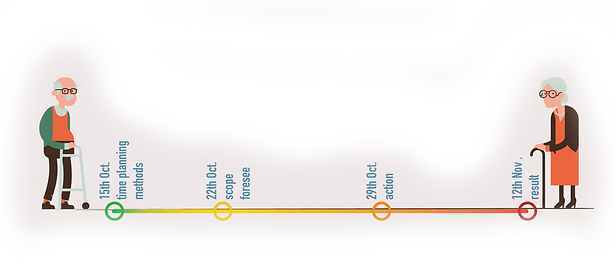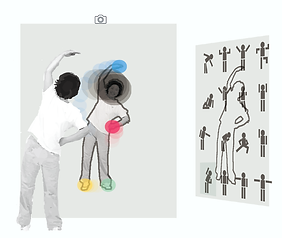

M.Fit
"M.Fit" is an app designed for 'active and healthy ageing' by combining music playing and physical exercising.
In the empirical field, we found that many elderly hold passive attitudes toward physical events, but music brings everybody in the same room.
Our design idea is to motivate elderlies to perform exercises by matching each movement with a corresponding note.
Show case

Methods
Observation
Interview
Workshops
End-user
Elderly
Duration
2016
My Role
User Research
Video editing
UX/UI design
Design Context
The Challenges
Germany is one of the most aged countries in the world--28.0% of the population of Germany was over 60 years old, and Dessau is the most aged city in Germany -- with 12.1% of the population above 80 years old.
Our project carried out a preliminary survey in Dessau. We observed 10 areas where the elderly gathered. Each designer interviewed 2 elderly in each place and shared the survey results afterwards.
My interviews were conducted with two seniors and a nurse in the care home. Furthermore, I experienced immersively their life in the care home for two days.
9 themes were summarised in the survey and our group brainstormed more than 100 design ideas together. In the end, my design idea concentrated on the topic of "healthy and active ageing" due to the fitness experience in the care home.
-
Request the appointment with elderlies in the care home
-
Gain trust relationship with elderlies
-
Understanding the elderly's behaviour from a different culture can be difficult
-
Cannot perform co-design activity due to the resource and time limitation
-
Limited german
Why do we design for elderlies?
The rapidly growing elderly population
In 2017 28.0% of the population of Germany was over 60 years old, and it is projected to increase to 37.6% by the year 2050.
The elderly are left behind by the fast-developing era
"...every day is the same for me, only my daughter visit me sometimes, and she is 62 years old..."
"...we want people here, young people, but not so many students keep coming..."
Modern technology ignores the needs of the elderly
"...yes, a phone for calling people, they(the grandchildren) stored their number for me, but that is all (I can do with the phone)"
They complained when they try the smartwatch, "...the screen is too tiny and my fingers are too big, I cannot use it, you know?
DESIGN QUESTION
How can we support active and healthy ageing?
Pre-study

Key Findings
User Needs
Micro
Independence
Groups
Learning
Routine
Communication
Conversation Trigger
Savings
Existing Infrastructure
Availablity of activities
Organized in circles
Grandchild Care
Looking for mates/relationship
Rides more in the bus
Experience
Marco
Lack of Technology familiarisation
Loss of social network
Health limitation
Loss of confidence
Generation gaps
Sense of Purpose
Sense of accomplishment
Require social roles
Structured time management
Expand life experience
Need technological support
Quality of life and integrity
Mental health is equal to body health
Add motivation for exercise
We voted for the top four Micro and Macro design problems in the group and develop our design ideas base on them.
Brainstorming and Design
Brainstorm base on the Top 4 design problems in group

Music motivates elderlies to participate in training in the care home
Decide on individual design topic after the group brainstoming and develop 3 design ideas.
Design idea 01
A stick plays music with detected movements

Problem:long learning curve
Design idea 02
Interactive public space: play music note within grided boarders
Problem:Hard to cooperate



Design idea 03
Exercise with music and guides

Camera detect movements

Music note plays when guide points are matched
Augmented Reality guide movements
Hints for body movments


Logo Design
Simple interface: set in 3 steps

03 Select type of exercise
02 Select level of complexity
Share to social media
Login

04 Select Music Type
Limitation
Due to the limited time and participation resources,
1. Individual empirical collection keeps original. The empirical findings from others can hardly develop in personal design projects due to the lack of understanding in-depth.
2. Lack of feedback from the user group. Design ideas cannot withstand deliberates due to the absence of co-design activity.
Take away
-
Collaborative teamwork expands the understanding of the design field and stimulates critiques and creativity.
-
Design problems are contextualized, and user needs can be very different than we expected. (e.g. mate-searching)
-
We learned that life quality is more important than life span for elderlies.
It was an earlier design case from 2015, and now I found the immaturity by reflecting on the subsequent projects. However, this is the first project that makes me see the potential of UX, realize how design could impact people in a meaningful way. It leads me to learn how to design for people, not restrict in visual experiences.



